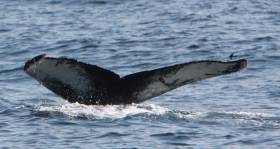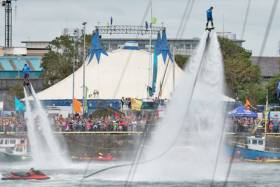Displaying items by tag: Nationwide RTE 1
#OnTV - Be sure to tune in to RTÉ One’s Nationwide tomorrow evening (Monday 30 July) for a special feature on whale watching and the Irish Whale and Dolphin Group’s (IWDG) conservation and research work.
RTÉ filmed with IWDG sightings officer Pádraig Whooley in October 2017 and more recently in mid May of this year, when presenter Anne Cassin and the Nationwide team travelled to West Cork for a day out with Cork Whale Watch.
It proved to be the perfect day for whale watching as the team filmed as many as 30 minke whales, more than 100 common dolphins, and the humpback whale known as HBIRL82.
See the results from 7pm on Monday 30 July on RTÉ One and later on the RTÉ Player.
SeaFest 2018 Features In This Wednesday’s RTÉ Nationwide
#OnTV - RTÉ One’s Nationwide will devote this Wednesday’s episode to this year’s SeaFest, Ireland’s national maritime festival, which welcomed over 100,000 visitors to Galway over the weekend.
Presenter Mary Kennedy spent a couple of days in Galway Harbour, talking to some of the key figures involved in the festival and enjoying some of the activities and events on offer.
She interviewed famous wildlife cameraman Doug Allan, who has captured amazing footage on documentaries including Blue Planet, Frozen Planet and Ocean Giants. Doug was at SeaFest all weekend to give talks about his experiences filming in some of the wildest and most remote places on earth.
The programme will feature an interview with Irish underwater cameraman Ken O’Sullivan. His documentary Ireland’s Deep Atlantic on RTÉ captured the attention of the nation with groundbreaking footage of sea creatures in Irish waters.
Nationwide also met with Marine Institute chief executive Dr Peter Heffernan, who spoke about the marine economy and last week’s Our Ocean Wealth Summit, as well as some of the technology innovations highlighted at the Marine Ireland Trade Show during the festival.
SeaFest features on Nationwide this tomorrow evening (Wednesday 4 July) on RTÉ One at 7pm, and will be available to watch online via RTÉ Player for 28 days afterwards.
#OnTV - A boatbuilding project on the shores of Lough Ree will feature in a segment of tonight's Nationwide on RTÉ One from 7pm.
The 'Mens Shed' scheme for the Lanesborough-Ballyleague area – as part of a job activation and family support initiative for the twin towns – brought together 14 men to learn the craft of boatbuilding.
And the results are more than impressive, with the team building four new boats in just 25 days – a "huge success" in the words of Ballyleague-Lanesborough Area Mens Shed chairman Joe Cribbin
He hailed the scheme as preserving traditional arts and crafts for a new generation.
"On this occasion, as the lads continue their voluntary work in painting the boats, we would like to thank each and every person who supported this project in any way.
"Our special thanks to Anthony Dockery of Roscommon Integrated Development Company and Bernie Morris of the Department of Social Protection, Ted and Sheila Falvey, Lanesborough Community College and Waterways Ireland."
Cribbin added that it's hoped two of the new boats will be ready to be blessed and launched by the June Bank Holiday weekend – Sunday 31 May at 2pm at the Ballyleague Waterways Ireland harbour slipway.
Link to the programme HERE.
‘Nationwide’ Sets Sail for the Galway Volvo Ocean Race
#VOR ON NATIONWIDE – In addition to coverage of the Volvo Ocean Race on TG4 as previously reported, the prestigious global yachting event will also feature in tomorrow's edition of Nationwide on RTE 1 at 7 p.m.
Tens of thousands of visitors will travel to the City of the Tribes to welcome the Volvo Open 70 boats the formula one cars of the ocean and enjoy the festivities.
Nationwide meets the people responsible for bringing the event to Galway for the second time and how the people of Galway have come together to make this spectacular a reality. The programme will also take a closer look at the iconic Galway hooker boats.
































































